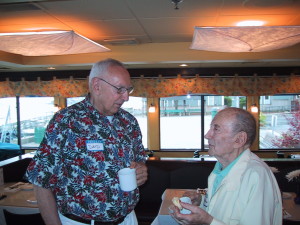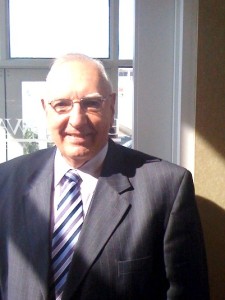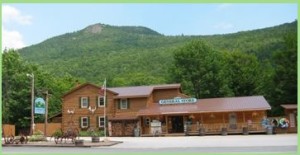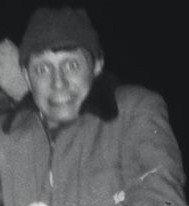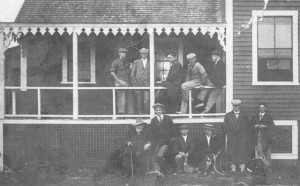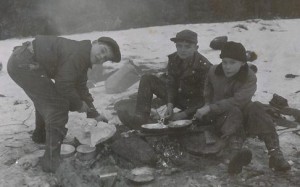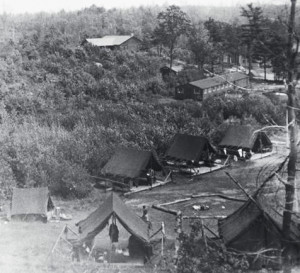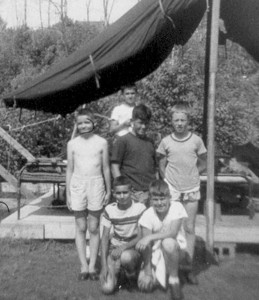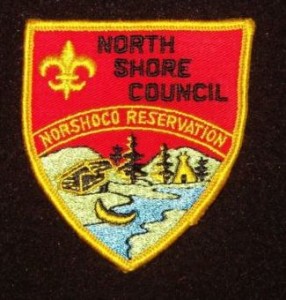It must have been at my 40th Marblehead High School in reunion in 1997 that some of us spoke of Dave Eckhardt, the scoutmaster we hadn’t seen since the mid 1950s. Someone, maybe Tom Hansen, remembered that he had moved to Chicago, and on a visit there had tried to look him up with no success. Someone else remembered hearing something about Dave living in Virginia and had tried to find him, again without result. The mystery of Dave Eckhardt rattled around in the back of my mind for a couple of years and I couldn’t let go of it. After all, I had played a role connecting him with Troop 3 in the first place. He had turned up as a border in the summer of 1951 in the house where we rented rooms at 18 Pearl Street when I was twelve. I mentioned that I was Boy Scout in Troop 3, and Dave, then age twenty-one, had jumped at the opportunity to get involved. Fifty years later, in April 2001, I undertook an internet search and found a David C. Eckhardt in Virginia Beach, VA. I sent off a letter and received an email from him several days later. That evening we spoke on the phone for an hour.
Dave had four grown children and two grandchildren. What brought him to Marblehead in 1951 was a job with Sylvania in transistor research following his graduation from Carnegie-Mellon University. His young single co-workers, he told me, spent their evenings in bars, but he wanted to do something useful with his spare time — his explanation for his non-stop dedication to our Boy Scout troop. He had discovered after his three and half years in Marblehead that he was better suited for sales than for research and had switched from Sylvania to IBM where he had worked mostly in Chicago. After IBM he moved to Virginia and began a real estate business. At seventy-one he managed an agency full time that dealt in condo time-shares. He added that he had raised his children through their teenage years as a single parent. I couldn’t think of anyone better prepared for single parenting than Dave Eckhardt after his experience with us.
At our forty-fifth high school reunion in 2002, I suggested to Hopper Cutler and Tom Hansen that we might do a Boy Scout reunion and bring Dave back to Marblehead for a visit. They agreed. After returning to St. Louis I dug into the job of locating as many alums as I could. I did a lot of this research using my internet connection at work during slack periods which my employer didn’t seem to mind. We had weathered the millennium bug thanks to intense preparation, and my job had become a lot easier. I started with a few addresses and sent letters and then emails. Everyone I contacted helped to locate others. The Yankee Clipper Boy Scout Council dug up old troop rosters from Marblehead going back into the 1930s and sent me copies. Of the 41 alums I found 22 were willing to come on the date we had set: May 22, 2004. At the Marblehead end, Hooper arranged for us to use the Masonic Hall on Pleasant Street and located a caterer who did a marvelous job with fried shrimp at low cost. Buck Grader volunteered the Landing Restaurant for a Saturday morning gathering and arranged lodging for Dave Eckhardt at the Boston Yacht Club.
Barb and I drove east from St. Louis and stayed at the Harborside House B&B on Gregory Street. Eckhardt, it developed, was flying in from China, and had missed a connection which would delay his arrival at Logan Airport until late Friday night, May 21. Hooper picked me up at the B&B and we drove into Logan to collect our prize. Dave seemed refreshed after three sleepless days on airplanes. Except for white hair, he looked just he had in 1954. We drove him back to the Boston Yacht Club where Buck Grader was waiting; it must have been well past midnight.
The reunion was well chronicled in The Marblehead Reporter by Dawn Bucket, George Derringer and Hooper and Joan Cutler. “Pic” Harrison supplied great photos. Here, in part, is what Hooper and Joan wrote:
Mr. Eckhardt (Dave) spoke of his gratitude being sought out after so many years, what these “kids” had meant to him, done for him, given back to him – not the other way around. A devout Christian, he told of his travels to Thailand living with a peace-loving gentle Buddhist family; or before yet another adventure, reading the Koran to better understand the Muslim family he would visit. …He shared his most recent journey: visiting a … Chinese English teacher. When asked to teach the class a song and poem, all he could think of was “John Jacob Jingle Heimer Schmidt” and “Peter Piper Picked, etc.” Then Dave encouraged all present (former Scouts, families and friends) to look at life as an adventure and recognize that just Marblehead or just Virginia Beach isn’t our world anymore. He enjoined all to open themselves, to embrace, to learn what the world is and what it will be. With his four children grown and twin granddaughters recently born, he continues to live by own words, embracing life, sharing himself with them and others just as he did 50 years ago. Lucky Troop 3.
“Pic” Harrison shared another perspective:
In concluding his remarks, Dave Eckhardt said that, “life was a continuing journey and that we all had much to look forward to.” After the applause Hooper Cutler, a third organizer of the event said, “Dave, why didn’t you tell us this fifty years ago!” For just a brief time while Dave was talking he was our leader once again, and we were the boys.
Next week: WRMC at Middlebury College

